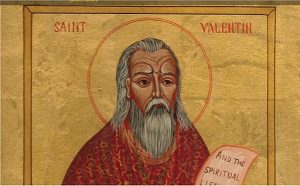The Feast of St. Valentine

http://interestingliterature.com/2014/02/13/the-literary-origins-of-valentines-day/, CC0, via Wikimedia Commons
By Rob Durocher,
Minister of Worship and the Arts
Long before Brach’s and Whitman’s began selling heart-shaped boxes of candy and Hallmark cards and a dozen roses and ‘let me call you sweet-heart’ became the focus of Valentine’s Day, February 14th was a much-celebrated Festival Day in the liturgical church year because it commemorated the death of possibly THREE St. Valentines all said to have been martyred on or near February 14th but in different years.
The first St. Valentine (also known as Father Valentinus of Rome,) was a priest in the early Roman Catholic Church and a physician in the third century AD. During this time many Christians were being persecuted for their faith under the rule of the Emperor Claudius Gothicus II. It was because of these persecutions that the ‘first’ St. Valentine joined the efforts of his priestly friend, St. Marius to minister to those persecuted for their beliefs as they awaited their execution or were living out long jail sentences.
There is a legend that St. Valentine was invited to appear before the Emperor Claudius II who was intrigued by the fame and good works of Valentius. The emperor urged him to renounce his faith and to adore the Roman gods. Valentius refused to do this and was immediately placed under house arrest in the custody of a Roman nobleman named Asterius who challenged Valentius to prove that the Christian God had more power than the Roman gods. Father Valentius was given the opportunity to preach to this household that Christ was the only one who could lead the pagan Romans out of shadows of darkness and into the light of truth and salvation. Asterius hearing this then challenged Father Valentius that if he could cure his daughter from her blindness, he and his whole house would convert to Christianity. Valentius prayed deeply over the young girl in God’s name and miraculously her sight was restored. His jailer was so overcome by this miracle that he immediately converted to Christianity. Valentius (against the Emperor’s orders) also continued to send ‘letters’ of love and encouragement to the Christian community who were oppressed, jailed an awaiting their execution reminding them to stay strong in their faith. (This is thought to be where the present-day tradition of sending Valentine’s Day cards originated). Sadly, for Father Valentius, when word of the healing of the blind girl and conversion of her family was made known to the Emperor he ordered Valentius’ execution by beheading on February 14, 270 AD on the Via Flamina in Rome.
Many years later another St. Valentius, Bishop of Terni appears in the history of the Valentines. This Father Valentinius had developed a reputation as a faith-healer. He was invited to Rome by Crato, a noted teacher of Greek and Latin whose son was suffering from a painful physical deformity that no doctor was able to heal. Crato promised Father Valentius half of his wealth if he would heal his son, but Valentius explained that neither wealth nor any personal gain would heal the young man but only his deep faith in the one true God could. Valentius spent much time praying over the boy and miraculously the boy began to heal and regain his health. Crato was so moved by this that his whole family asked for more instruction towards belief and were eventually baptized by Bishop Valentius as were many others within Crato’s family and community. This included the son of Placidus, the prefect of Rome who was greatly angered by his son’s conversion in a time when Christians were being persecuted. Placidus ordered the immediate arrest and execution of Valentius of Terni which had to be carried out at night so not to anger and stir up Valentius’ friends. He too was beheaded on the Via Flamina in Rome in the reign of the Emperor Claudius II, (but possibly during the reign of the Emperor Aurelian) around 273 AD.
There are many similarities that both St. Valentines have in common. They were executed on the Via Flamina and became martyrs between 270 -273 AD and were alleged to have died on February 14 though some years apart. Because of this, leading scholars have wondered if they were in fact really just one St. Valentine.
As if to complicate Valentinian history, there is also a ‘third St. Valentine’ but much less is known of him except that he was like the other two St. Valentines, a brave and discipling priest known for his love of the Lord and His church. This St. Valentine was in Africa when he too suffered martyrdom with several of his friends and companions for his preaching. He too is given a February 14th date of death.
The one uniting fact for our celebrated St. Valentines is that they all died because of their love for God and for their desire to spread God’s kingdom by love and example to their communities.
In the fourth century AD Pope Julius I built a basilica near the site where St. Valentine’s tomb was thought to be, but in the thirteenth century Valentine’s relics were placed in the Church of St. Praxedes near the Basilica of St. Mary in Rome where they rest today. St. Valentine was Canonized Pre-Congregation. (Canonization of saints by local bishops, primates or patriarchs prior to modern investigations by ecclesiastical institutions).
The origins of St. Valentine’s Day shadows the pagan holiday of Lupercalia (a pagan love/fertility type of celebration amongst the Romans that continued to be celebrated a century after Christianity became legal in Rome). In the fifth century Pope Gelasius ended the pagan festival and soon after that decreed that February 14 was to be ‘a day of feasts to celebrate the martyred Saint Valentine’. In the Middle Ages, displays of love and affection became a popular custom for titled Lords and Ladies on St. Valentine’s Day eventually turning into the extremely commercial and expensive event that we experience today!
So if you are one who celebrates Valentine’s Day, when we exchange Valentine’s Day cards or enjoy a heart-shaped box of chocolates or a dozen roses or whatever your Valentine’s Day tradition might be, let’s also remember that what seems to have become a secular custom has a deeply rooted Christian message: The love of Christ is a self-less, unconditional love that we are called to express in our lives, example and in our daily walk of faith. Just like St. Valentine showed in a love that bore witness to his faith by losing his own life to martyrdom, let’s remember the words of Jesus who said ‘This is my commandment that you love one another even as I have loved you. Greater love has no one than this – that you should lay down your life for your friends.’ (John 15:12-13.) Happy Valentine’s Day!
Related Posts

Holy Land Pilgrimage



